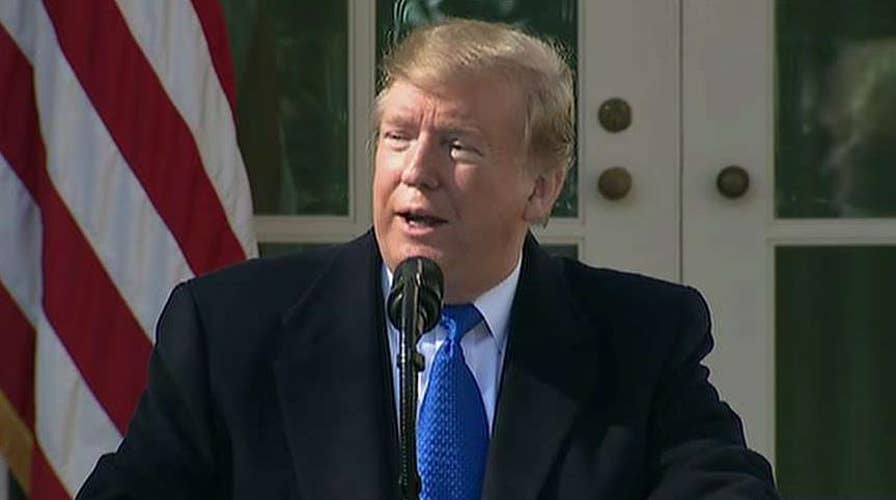President Trump cites drug trafficking and crime in declaring national emergency at border
William La Jeunesse takes a closer look at the crisis at the border.
The fight against drug trafficking in our country has been a continuous and devastating battle. Millions of American lives have been impacted, and we have seen the destructive power illegal drugs can unleash on a community. In an effort to better understand where these drugs are manufactured and how they enter our country, the Drug Enforcement Administration analyzes specific narcotics to identify their geographic sources.
In 2017, 91 percent of heroin analyzed in the U.S. could be traced back to Mexico, 93 percent of the cocaine analyzed in the U.S. could be traced back to Colombia, and the amount of methamphetamine analyzed in the U.S. that was produced in Mexico could range as high as 97 percent. According to the 2018 National Drug Threat Assessment, the southwest border remains the primary entry point of heroin, cocaine, and methamphetamine coming into our county.
In his State of the Union Address, President Trump called for increased border security to help limit the flow of drugs across our southwest border. As a member of the Border Security Subcommittee of the Committee on Homeland Security, I agree that we must commit to secure our southwest border, and part of that effort should include a physical barrier. Although most of the drugs seized by law enforcement takes place at points of entry, it is not known how much is being smuggled across the unsecured sections of our border or how many smugglers enter the country undetected.
CARFENTANIL, OPIOID THAT CAN BE LETHAL TO THE TOUCH, BECOMING A GROWING PROBLEM IN US
Fighting the flow of drugs into our country requires us to drive smugglers to secure points of entry where they will be met by border agents equipped with high-tech devices used to detect narcotics. Therefore, it is crucial that we seal unsecured points of entry so that we can concentrate our limited manpower to secured points of entry. We must increase the technology, equipment, and the manpower of Immigration and Customs Enforcement (ICE) and border security agencies. If we allow points of weakness along our border, then the flow of drugs into our country will shift to those points and continue to spill into our communities. President Trump’s comprehensive plan to secure our border must be adopted in full to successfully repel the continued trafficking of drugs into our country.
While a District Attorney in Mississippi, I prosecuted those who sold or transported illegal drugs into our communities. We were able to stop many drug dealers from creating footholds in the towns we represented, but as soon as we would put one criminal behind bars, another would appear with a new drug more devastating than the last. Throughout my career, I saw methamphetamine overthrow cocaine, which was then replaced by heroin and the rise of opioids. The newest illicit narcotic to hit our streets, fentanyl, is far deadlier than any drug we have seen before. In 2017, fentanyl accounted for almost twice the number of deaths as heroin and almost three times the number of deaths as meth. This is due to the potency of fentanyl. Only 2 milligrams of fentanyl, roughly the amount of a few grains of sand, is a lethal dose.
CLICK HERE TO GET THE FOX NEWS APP
Heroin, cocaine, meth, and most illicit drugs are overwhelmingly manufactured overseas and smuggled into our country across our open borders. Fentanyl is no different. The drug is mostly manufactured in China, where it is often shipped to Mexican Transnational Criminal Organizations (TCOs) to be smuggled across our southwest border in bulk. These TCOs, or drug cartels, have been very successful in transporting fentanyl into communities across the country. Two weeks ago, border patrol agents seized over 115 kilograms (253.5 pounds) of fentanyl – enough to provide fatal doses to over 57 million Americans – being smuggled into the U.S. by a Mexican national through our southwest border, according to an article released by U.S. News. In another report, enough fentanyl was found in my home state of Mississippi last August to kill half a million people, or about 14 percent of the population of our state.
Securing our border against cartels that seek to profit from the addiction and destruction that drugs have on American lives is a matter of national security, and immediate action is needed in Congress. I support President Trump’s plan to secure our border and believe his approach that includes a physical barrier is necessary to protect our communities from the growing dangers of fentanyl, street-level narcotics, and synthetic prescription drugs. I look forward to working with my colleagues on both sides of the aisle to address this growing epidemic.

